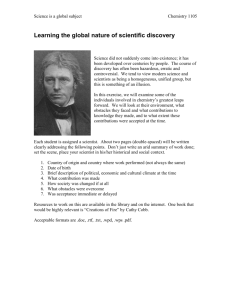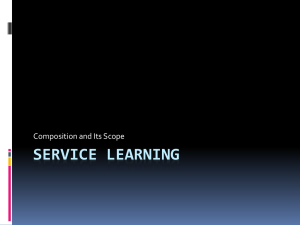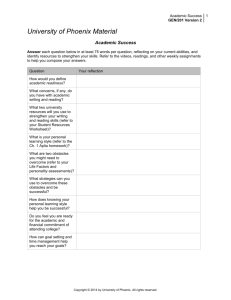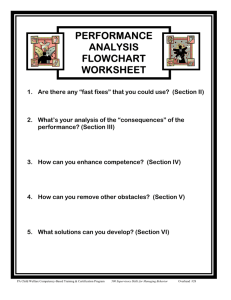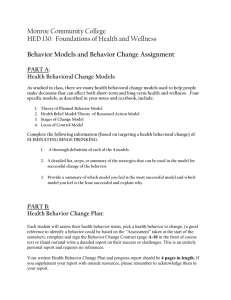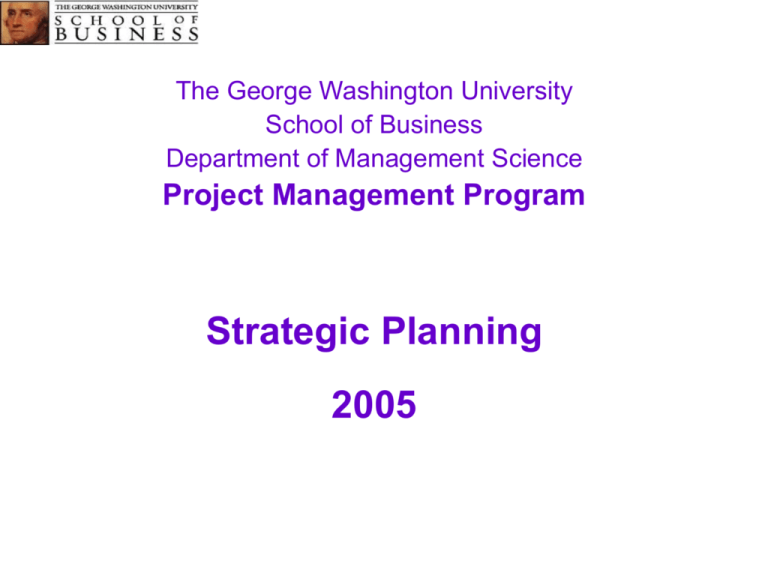
The George Washington University
School of Business
Department of Management Science
Project Management Program
Strategic Planning
2005
Master of Science in Project Management (MSPM)
• Background of the PM program
– Program founded in 1996
– 10th anniversary in 2006
– Distance education mode established in 1998
– MSPM Graduates as of December 2004
426
– Enrollment per year (average)
122
– Active Students (average)
290
2
Active Students in the PM Program
MSPM Enrollments
350
No. of Active Students
300
250
200
150
100
50
0
fall 00
spring 01
fall 01
spring 02
fall 02
spring 03
fall 03
spring 04
fall 04
Main Campus
112
113
119
129
135
122
138
124
124
Distance
123
132
142
136
162
168
161
164
173
Total
235
245
261
265
297
290
299
288
297
3
19
80
19
82
19
84
19
86
19
88
19
90
19
92
19
94
19
96
19
98
20
00
20
02
20
04
0
50,000
100,000
150,000
Source: Project Management Institute, Inc. All rights reserved. As of August 2005.
99,483
120,981
150,000
54,998
70,035
86,698
25,004
31,333
43,101
9,803
12,053
17,059
7,744
8,413
8,817
5,883
6,570
7,356
4,905
5,272
5,699
3,503
3,363
4,406
2,545
PMI Members
200,000
200,000
Global Growth of PMI® Membership
250,000
4
Global Growth of PMP® Certification
120,000
100,000
PMPs
80,000
60,000
40,000
20,000
Year
As of August 2005.
20
05
20
02
19
99
19
96
19
93
19
90
19
87
19
84
0
Selected Graduate Programs in PM
•
•
•
•
•
•
•
•
•
The George Washington University (GW)
University of Texas at Dallas
Western Carolina University
Stevens Institute of Technology
DeVry University
University of Maryland
University of Wisconsin, Platteville
Boston University
International programs
…
6
Strengths
•
•
•
•
•
•
GW name
GW Location
Application area independent
Program in School of Business
Among first graduate programs in PM
Respect of GW PM program by employers,
industry, government, and other universities
• PM Student Association and graduates
7
Weaknesses
• Current standing of PM program in school and
department
• Minimal number of PhD students
• Administrative staff turnover
• Faculty shortage
• 2/3 of PM faculty non tenure accruing (NTA)
– Was this related to uncertainties at the time the
program was founded?
It is time to rethink the PM program and its NTA
faculty positions
8
Opportunities
• Growing interest in PM in organizations
• Rapidly growing demand for PM education
• Opportunities to:
–
–
–
–
–
–
Conduct productive research
Publish in main stream / top tier journals
Obtain research funding
Strengthen the program
Enhance program reputation
Increase student enrollment
…
9
Threats
• New and increasing competition
• Attractive, visible, competitive programs
• Distance education reduces inherent location
advantage
…
10
Strategy Development
Focus Question
How to be the leading PM program (in the
world) through research, education, and
service and thereby increase understanding
of the contributions of PM to business
education and to society?
Method Source: Prytula, Cimesa, and Umpleby (2004). Improving the Performance of Universities In Transitional Economies.
The George Washington University.
11
Strategy Deployment Planning
• Vision
– What do we want to achieve in the next 1 – 3 years?
• Obstacles
– What is blocking us from moving toward our vision?
• Strategies
– What innovative practical actions will deal with the
barriers and move us toward our vision?
• Actions
– What do we want to accomplish in Fall 2005, Spring
2006, and Summer 2006?
Method Source: Prytula, Cimesa, and Umpleby (2004). Improving the Performance of Universities In Transitional Economies.
The George Washington University.
12
Vision
•
Innovative PM Curriculum
–
–
–
–
–
Most innovative Program
Entertain new ideas (venue)- journals, conferences
Excellent course lineup
More interactive online instruction
High quality teaching
Continued…
13
Vision (Continued)
• Active involvement / Outreach to
organizations
–
–
–
–
–
Most appreciated service
NGO partnerships
Most cited program for service to society
Leadership roles in PM organizations
Recognized editorial positions in PM journals
Continued…
14
Vision (Continued)
• PM Research Leadership
–
–
–
–
–
–
–
Continuous research funding
Most funded research
Most research active group
Excellent research output
Most read (cited) articles
Most admired conference presentations
Having a journal
Continued…
15
Vision
(Continued)
• Program of choice for best students
–
–
–
–
–
Most sought after program
Increased student enrollments
Highest GPA applicants
Highest entry requirements
Top notch students
Continued…
16
Vision
(Continued)
• Most desired PM degree by employers
– Most recognized PM program (in Government and
industry)
– Industrial partnerships
– Most desirable graduates by employers
– Most highly respected qualifications of graduates
– Program Alumni as CEO of respected organizations
Continued…
17
Vision
(Continued)
• Most recognized PM program
–
–
–
–
–
–
Highly respected program in academia
Most sought after educational partner
Highest ranked in US News & WR survey
Best recommended program
Highly respected in PM community
Identify PM as a separate discipline in Rankings
Continued…
18
Vision
(Continued)
• Well respected program in University
– All tenure track faculty
– Best paid PM instructors in field
• Good management of PM program
– Standard CMMI
19
Obstacles
• An Emerging Discipline
– Lack of acceptance as separate profession
– Lack of recognition as a discipline
– PM community’s emphasis on training not education
Continued…
20
Obstacles (Continued)
• A competitive education environment
–
–
–
–
Competitors!
We are expensive
High tuition fees
Competing programs with more resources
Continued…
21
Obstacles (Continued)
• Insufficient faculty in Program
–
–
–
–
–
–
–
Limited faculty lines
All assistants (one associate congratulations! )
No tenured faculty
Lack of encouragement
Not well recognized in the department
Lack of respect in the department
Dependency on outsiders to teach approximately
half our courses
– Low salary level in the school of business (recruiting)
– People going on sabbatical
Continued…
22
Obstacles (Continued)
• Emerging education delivery modes
– Distance education students are not well cared for by
university
– Limited computing infrastructure (re: distance
education)
– Somewhat removed from distance students
Continued…
23
Obstacles (Continued)
• Need continuous telling of a positive story
– Lack of communications with PM communities and
societies
– Insufficient promotion of successes (mostly internal)
– Failed initiatives (Aiken)
– Insufficient outreach to employers
Continued…
24
Obstacles (Continued)
• Contradictory (not aligned) reward system
– University’s “rewarding A while asking for B”
–
–
–
–
–
A = research, B = teaching
Pressure from the administrators regarding top tier
journal publishing
Pressure to recruit/increase student enrollments
Lack of management support
Teaching centric environment
No University recognition for service to society
Continued…
25
Obstacles (Continued)
• A challenging group of students
– Lack of resources (number of hours / courses)
teaching delivery
– Some unhappy graduates
– Mixed group of students in their qualifications
Continued…
26
Obstacles (Continued)
• Limited generic PM research support
– Limited research funding opportunities
– Difficulty in obtaining PM data
– No GW funding release for research
– Lack of funding by outside organizations
– No steady stream of research students
– Discipline-independence program
Continued…
27
Obstacles (Continued)
• Limited time for research, etc.
– Heavy teaching load
– Teaching too many courses
– Teaching load, especially with distance education
courses
Continued…
28
Obstacles (Continued)
• Insufficient internal communication (on
vision)
–
–
–
–
We did not have a vision before!
Culture-less (rituals, symbols)
No PM retreat
Lack of strategic planning
29
Strategies
• Form PM research forum
– Form focus group(s) for funding research requests!
– Research that is understood and appreciated by the
department
– Improve internal research communication and
information exchange
Continued…
30
Strategies (Continued)
• More interactive Program management
–
–
–
–
Rotate leadership
Enhance esprit-de-corps in program
Regular bi-weekly meetings
Conduct regular meetings and updates to strategic
plan
– Documented follow-up action list
Continued…
31
Strategies (Continued)
• Continually improve teaching quality
– Improve delivery of program (particularly for distance
education)
– Maintain distance education weekly chats
– Add discipline specific “specializations” or electives
– Request highly visible class projects from NGO’s /
Industry
– Seek PMI® recommendations as program for
advanced PM (beyond PMP®)
– Benchmark
Continued…
32
Strategies (Continued)
• Continually improve teaching quality (Continued)
–
–
–
–
–
Review/update curriculum
Standard course material developed jointly
Better group oversight of PM courses
Keep recordings up-to-date
10-year review
Continued…
33
Strategies (Continued)
• Take charge of recruiting
– Hire a professional recruiter
– Continuous monitoring of competitive market!
– Strengthen student recruitment to obtain a very qualified
pool
– More selective recruitments!
Continued…
34
Strategies (Continued)
• A balanced, clear department reward system
– Institute the new department
– New clear and transparent bylaws!
– Reduce teaching load for each published paper
(Q.C. to be agreed)
– Decide on student-number goal (i.e., total number of
students in program)
– Use PM program revenue for Research Assistants
– Research buy-out
Continued…
35
Strategies (Continued)
• A balanced, clear department reward system
(Continued)
– Say “no” to some outside overtures (i.e. , be more
selective, e.g. China)
– Make research a priority until tenure achieved
– Request faculty lines proportional to generated
revenue
– Pursue tenure accruing positions
– Provide incentives (for research, education)
– Reward teaching and service to societies /
professions
Continued…
36
Strategies (Continued)
• More active promotion marketing
–
–
–
–
–
–
–
–
–
Continuous promotion of PM as a discipline
Refine/update story of PM program
Enhance external marketing efforts
Celebrate 10th Anniversary very visibly
Better marketing and promotion of the program
Better branding
Better networking
PM newsletter (keep it going)
Strengthen understanding of discipline through
dissemination of knowledge
37
Actions
A. Form PM research forum
Fall 2005:
Weekly research presentations of various lengths and
origins
Discuss research opportunities with DSOM faculties
Publicize research forum via email to GWSB and doctoral
student lists
Make list of PM research funding organizations
Continued…
38
Actions (Continued)
Spring 2006:
Establish research advisory group and identify
research funding opportunities
Summer 2006:
Setup the e-journal on our website
Write proposals and receive feedback, then submit
proposals
Continued…
39
Actions (Continued)
B. More interactive program management
Fall 2005:
Use QIPM to prioritize strategies
Plan regular meetings. Schedule and conduct same
Spring 2006:
Get more administrative support
Plan regular meetings. Schedule and conduct same
Continued…
40
Actions (Continued)
C. Continually improve teaching quality
Fall 2005:
Develop structured recording schedule
Develop a schedule to review the courses
Recording schedule
Develop recording policy
Prepare common repository of course material (shared
drive?)
Continued…
41
Actions (Continued)
Spring 2006:
Recording schedule
Prepare a common set for classes being taught in
Summer / Fall ’06
Have a policy for course material
Summer 2006:
Record
Review/enhance common set of slides and handouts
(lot of work)
Create course folders
Continued…
42
Actions (Continued)
D. Take charge of recruiting
Fall 2005:
Decide program presence at conferences throughout
the next 12 to 18 months
Update recruiting strategy (particularly for distance )
Tap into student markets
Continued…
43
Actions (Continued)
E. A balanced, clear Department reward system
Fall 2005:
Meet with DSOM to discuss department reward system
Write papers
Write by-laws
Continued…
44
Actions (Continued)
Spring 2006:
Write papers
Get Prof. Frank and Prof. Young tenured
New department by-laws
Summer 2006:
Write papers
Continued…
45
Actions (Continued)
F. More active promotion and marketing
Fall 2005:
Define marketing plan
Identify target publications and conferences
Spring 2006:
Develop and roll out
Volunteer faculty for target conferences / journal
Continued…
46
Actions (Continued)
Summer 2006:
Volunteer faculty for target conferences / journal
Get PMI® accreditation
47

